Thanksgiving cactus is a very popular blooming plant around the holidays, and it’s easier to care for than you might think.
With bright indirect light, fast-draining soil, and consistent watering, you can enjoy your Thanksgiving cactus year-round, and get plenty of beautiful blooms in November.
In this post, I’ll give you all of the details about Schlumbergera truncata care, and also guide you through pruning, fertilizing, and propagating. Plus I’ll give you tips for treating common pests and diseases, troubleshooting problems, and answer your FAQs.
Learn how to care for your Thanksgiving cactus the right way, so you can enjoy the beautiful flowers for decades to come.
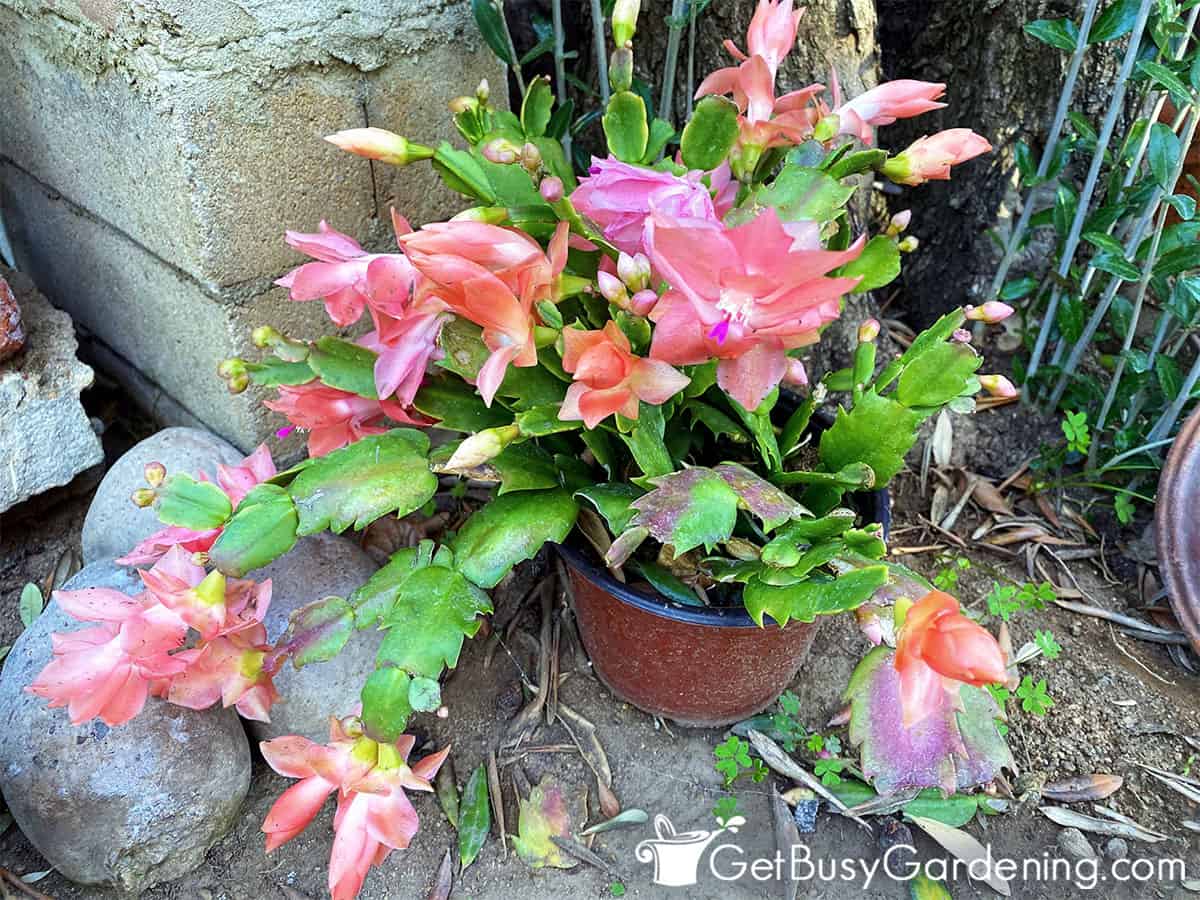
Thanksgiving Cactus Quick Care Overview
| Scientific name: | Schlumbergera truncata |
| Classification: | Succulent plant |
| Common names: | Thanksgiving cactus, November cactus, crab cactus |
| Hardiness: | Zones 10-11 |
| Temperature: | 65-75°F |
| Flowers: | Pink, magenta, red, orange, yellow, white, bi-colored, blooms in late fall |
| Light: | Partial shade |
| Water: | Consistently moist, do not overwater |
| Humidity: | High |
| Fertilizer: | Flowering plant food in spring and summer |
| Soil: | Fast-draining, sandy soil |
| Common pests: | Mealybugs, scale, fungus gnats |
What Is A Thanksgiving Cactus?
Thanksgiving cactus (Schlumbergera truncata), aka November cactus, is just one type of holiday cactus. Despite their name, they’re actually a succulent native to tropical forests in Brazil, often found in trees or on rocks.
Since they’re epiphytes like orchids or bromeliads, they get their nutrients and moisture from the air and the surfaces they attach to, rather than depending on soil.
Their long arching branches are made up of segmented, leaf-like pads. Each pad has edges that are toothed, or claw-like, giving them one of their common names, “crab cactus”.
If yours has smooth leaves instead, then it’s a Christmas cactus, and here’s how to care for it.
A mature specimen can grow between 12-24” tall, and they can live in pots or gardens for decades given the proper care.
Related Post: How To Care For A Holiday Cactus Plus Growing Tips
Flowers & Bloom Time
Thanksgiving cactus is a popular plant to grow during the holidays because it shows off its gorgeous flowers when most others are done for the year.
In fact, that’s how they earned their other common names “Thanksgiving” or “November” cactus, because of the timing of the blooms.
During the late fall, tubular flowers with beautiful spreading petals open up at the end of the branches.
Depending on the variety, they come in a range of colors including pink, magenta, red, orange, yellow, white, or even bi-colored.
And by following a few easy steps, you can force your Thanksgiving cactus rebloom again year after year.

How To Grow A Thanksgiving Cactus
Choosing a good spot is the first step to keeping your Thanksgiving cactus growing for years. They need well-draining soil and bright, indirect light indoors, or partial shade outdoors.
Allow the soil to dry slightly between waterings, and keep it drier in winter. Feed regularly with a flowering fertilizer during growing season.
Then give them a cool rest period and darkness in the late summer or early fall for the best holiday blooms.
Hardiness
Schlumbergera truncata is a tender perennial that’s hardy in zones 9-11, where they can grow outside year round.
If you live in a cooler climate, they can be kept as houseplants, or overwintered indoors when temperatures begin to drop to below 50°F at night.
Where To Grow Thanksgiving Cacti
Thanksgiving cacti grow best in light or partial shade outdoors, or indoors in a place where they get bright, indirect sunlight.
They can thrive in containers both in the house and outside, which makes them easier to move inside during freezing temperatures.
The arching segmented branches make them popular for hanging planters and baskets.
For warmer climates, they can live in the ground in your garden, or even on the branches of a tree or mounted on a board or log.
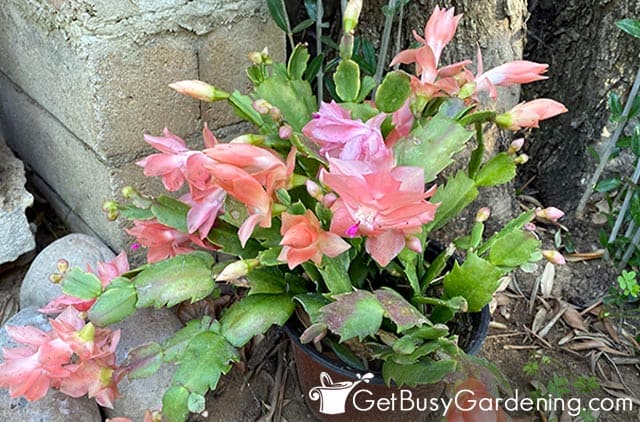
Thanksgiving Cactus Plant Care Instructions
With your ideal growing location ready to go, it’s time to learn about how to care for your Thanksgiving cactus so you can enjoy the blooms every year.
Sunlight
In their native habitat, Schlumbergera truncatas grow under the canopy of trees. So, outdoors keep them in a dappled or partially shaded area.
Indoors, give them a spot that gets bright, indirect light for part of the day, but keep them protected from the hot afternoon rays.
Too much direct exposure can cause the leaves to redden, shrivel, or get sunburned.
When fall arrives, they need between 12 to 16 hours of darkness to form flower buds, then 8 to 10 hours of sunlight to bloom.

Water
Thanksgiving cacti have average water needs and don’t like to dry out, but are susceptible to root rot from overwatering. They get moisture from the air, rain, and the surfaces they sit on.
So keep the soil evenly moist without pooling the area near the roots. When the top inch has dried out, moisten it thoroughly, but not to the point where it becomes soggy.
The heat during the summer can dry them out faster, so you may need to increase how often you water. If you struggle to get it right, a soil moisture gauge is a great tool to have.
Learn all about when and how to water your Thanksgiving cactus here.
Humidity
Since they take in moisture from the air, humidity is important for them to thrive. Outdoors this isn’t usually a problem. But if your indoor air is dry, you’ll need to try to increase it.
A water-filled pebble tray under the pot, daily misting, or running a humidifier nearby are all great choices. Too much water sitting on the leaves can cause rot however, so mist lightly.
Temperature
Another big factor in successful Thanksgiving cactus care is temperature, and they can be very fussy about this – especially during blooming.
They prefer moderate temperatures at all times. Freezing weather will kill them, while extreme heat can cause them to wilt, shrivel, burn, or drop their flowers and buds.
In the fall, they need cooler weather between 50-60°F at night in order to form flower buds. Once the buds appear, slightly warmer daytime temps in the 60-70°F range are ideal for blooming.
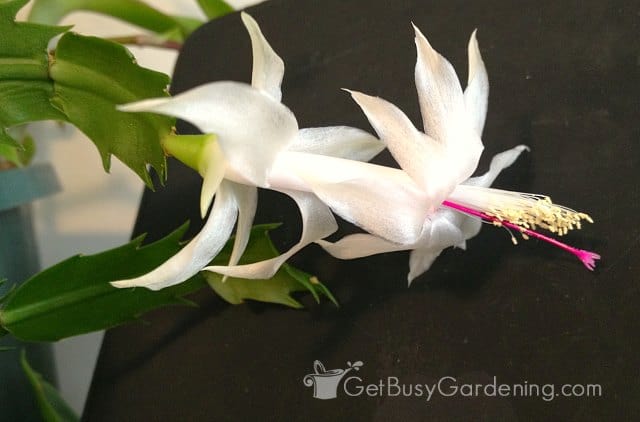
Fertilizer
Using a diluted, natural liquid fertilizer twice a month during the Schlumbergera truncata growing season (spring and summer) can encourage more flowers.
You can apply a general purpose type, a compost tea, or use one that is specifically for flowering plants.
Stop fertilizing when they start blooming in the fall, and hold off until you see new growth begin again in the spring.
Soil
They aren’t super fussy about the type of soil. But a slightly acidic, porous mix that’s rich in organic matter is ideal.
I like to use a high quality potting soil amended with perlite, and sand or bark. But a succulent mixture will work great too.
Since they’re epiphytes, they don’t actually require soil at all. You can mount them to a board or log using sphagnum moss. Just keep in mind this will require more misting and watering, especially indoors.
Repotting
Your crab cactus will actually bloom better when pot-bound. They have shallow roots, and don’t require repotting very often.
So, as tempting as that cute new planter is, it’s better to save repotting only for when they absolutely need it.
The signs they need to be moved into a new pot are when they stop putting on new growth, or when there are less flowers than previous years.
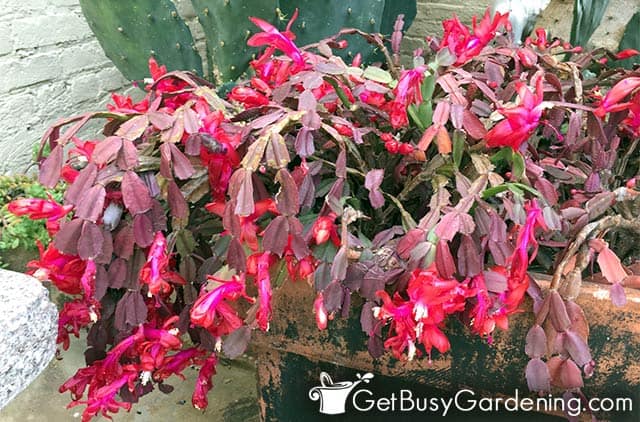
Pruning
Though not required, pruning your Thanksgiving cactus is a great way to encourage bushier growth and more flowers.
It’s best to do this in the spring, after they’re done blooming and the branches are growing again.
Use sharp, sterile pruning shears to snip between leaf segments. Or you can simply twist them off gently.
Two new branches will form from those spots, and the clippings can be saved for propagating into new plants.
Related Post: What To Do With Thanksgiving Cactus After Blooming (5 Tips!)
Pest Control Tips
Thanksgiving cacti are generally free of most pests, but they can occasionally get infested with mealybugs or spider mites.
A homemade spray made with 1 teaspoon of mild liquid soap per liter of water is a highly effective way to treat them. Or you can buy a premade insecticidal soap.
You can brush or rub the bugs off off with a cotton swab soaked in rubbing alcohol to get a head start. Neem oil also works great.
Dormancy
In order for those stunning blooms to show up at the right time in November, they need a brief period of partial dormancy.
Starting in late summer or early fall, reduce watering, and move it to a cool place away from heater vents. They need 12-16 hours of total darkness a day for 6-8 weeks in order to form buds.
When you see the flower buds beginning to appear, return to your regular watering schedule, and give it plenty of bright, indirect light during the day.
Make sure to protect it from the heat and direct sun, or the buds could start dropping. Also, once it begins blooming, don’t move it again until it’s done, or the flowers may drop off.
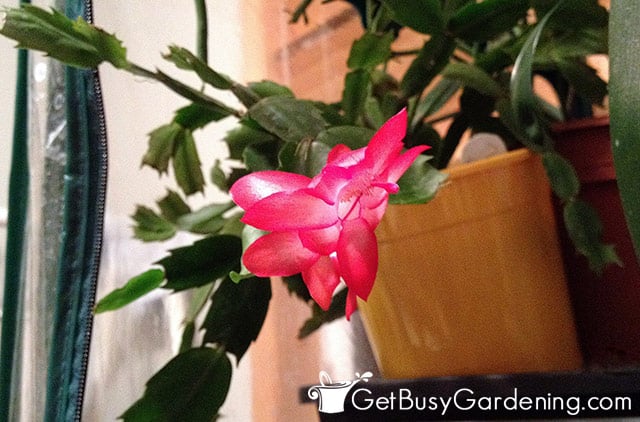
Schlumbergera truncata Propagation Tips
Multiplying your Thanksgiving cactus is actually really easy, and can be done every year during the springtime.
Simply twist off a healthy branch 3 to 5 segments long, and allow it to callous over for a day or two. Or try using a single leaf.
Then dust them with rooting hormone and bury the bottom segment halfway down into a fast-draining soil mixture.
Place them in a warm, bright location, and keep them evenly moist until you see new growth on top.
Related Post: Propagating Christmas Cactus From Cuttings Or By Division
Troubleshooting Thanksgiving Cactus Problems
Troubleshooting common growing problems is a key part of Thanksgiving cactus care. Here are my solutions to some of the issues you may face.
Limp Or Droopy Leaves
Leaves that are limp, mushy, or drooping are often caused by overwatering. Make sure the soil is moist, but not to the point of puddling, and never leave the roots or pot in sitting water.
However, wilting could also be a sign they aren’t getting enough moisture. So check the soil, and add water if it’s completely dried out. It’s best to use a moisture meter to know for sure.
Flower Buds Dropping
There are a few reasons why a Thanksgiving cactus will start dropping its flower buds. Too high of temperatures, letting the soil dry out, overwatering, or not providing enough light can all be causes.
Ensure the temperature stays below 70°F during blooming. Also keep the soil evenly moist, and mist it to increase humidity.
Although they require extended periods of darkness to trigger flower formation, they need 8 to 10 hours of bright, indirect light during the day as well.
Thanksgiving Cactus Not Blooming
High temperatures or too much light can prevent your Schlumbergera truncata from blooming. They need cool nights of 50-65°F to trigger bud formation, and 12-16 hours of complete darkness.
If you’ve recently repotted it, that may be the reason it’s not flowering. They prefer to be pot-bound, and it could take a year or so for them to return to a regular blooming schedule.
Recently propagated young plants can also take a few years to flower.
Leaves & Segments Dropping
Overwatering or extreme temperatures can cause the leaves and segments to drop off of your crab cactus.
Don’t let the soil get sodden with water, and keep them out of freezing or very hot temperatures.
Root or stem rot could also be the culprit, so make sure to check the base of the stem. If it’s soft or mushy, then it’s best to take healthy cuttings and root them to save your plant.
Thanksgiving cactus blooming in spring
When a Thanksgiving cactus blooms in the spring rather than in November, it means the timing of their cool dormant period wrong.
It’s very important to give them a period of partial darkness and cool temps in the fall, and timing is everything.
To get it right, start reducing how much you water, and give them long nights in complete darkness in early fall. Ensure it stays above freezing, but below 65°F to trigger flower formation at the perfect time.

Thanksgiving Cactus Care FAQs
Here you’ll find answers to the most commonly asked questions about growing a Thanksgiving cactus. If yours isn’t answered here, please ask it in the comments section below.
How fast does a Thanksgiving cactus grow?
A Thanksgiving cactus can grow very fast. With the proper care, they can reach their full size of 24” in just a few years.
If yours is experiencing very slow growth, it may be time to repot it, or try fertilizing in the spring and summer.
Are Thanksgiving cactus indoor or outdoor plants?
Thanksgiving cactus can be either indoor or outdoor plants, depending on where you live. They’re commonly kept as houseplants in regions that experience freezing temperatures during the winter.
They can be moved outside in the spring and summer when nighttime temps are above 50°F. Gardeners in zones 9-11 can leave them outside all year.
Should I mist my Thanksgiving cactus?
You should mist your Thanksgiving cactus if your home has very dry air. They draw moisture from the air, so humidity is important. But to avoid rot, don’t let water sit on the leaves for long periods after misting.
How often should I water my Thanksgiving cactus?
You should water your Thanksgiving cactus only often enough to keep the soil evenly moist. Don’t let it dry out too much, or you may see shriveling or wilting leaf segments. But avoid getting it so wet that there is standing water, or the roots may rot.
How much light does a Thanksgiving cactus need?
A Thanksgiving cactus needs 8 to 10 hours of indirect, bright light per day, with 12-16 hours of complete darkness in early fall to trigger flowering. Outdoors they do best in partially shaded or dappled sun areas.
Learning about Thanksgiving cactus care is important to ensure you can enjoy the beautiful, colorful blooms every year. Once you get the hang of it, you’ll be able to grow your Schlumbergera truncata for decades to come.
If you want to learn all there is to know about maintaining healthy indoor plants, then you need my Houseplant Care eBook. It will show you everything you need to know about how to keep every plant in your home thriving. Download your copy now!
More Holiday Plant Care Guides
- How To Care For An Easter Cactus Plant (Schlumbergera gaertneri)
- How To Care For An Amaryllis Plant
- How To Care For Poinsettia Plants
- How To Care For Cyclamen Plants
More Epiphyte Plant Care Guides
- How To Grow & Care For Rabbit’s Foot Fern (Davallia fejeensis)
- How To Care For An Orchid Cactus Plant (Epiphyllum)
- How To Care For Staghorn Fern (Platycerium bifurcatum)
Share your Thanksgiving cactus care tips in the comments section below.
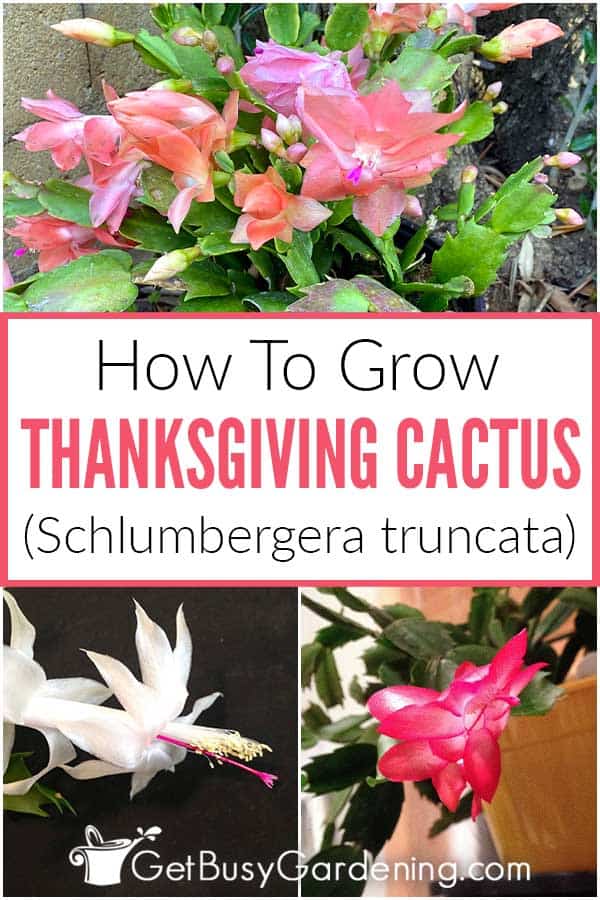
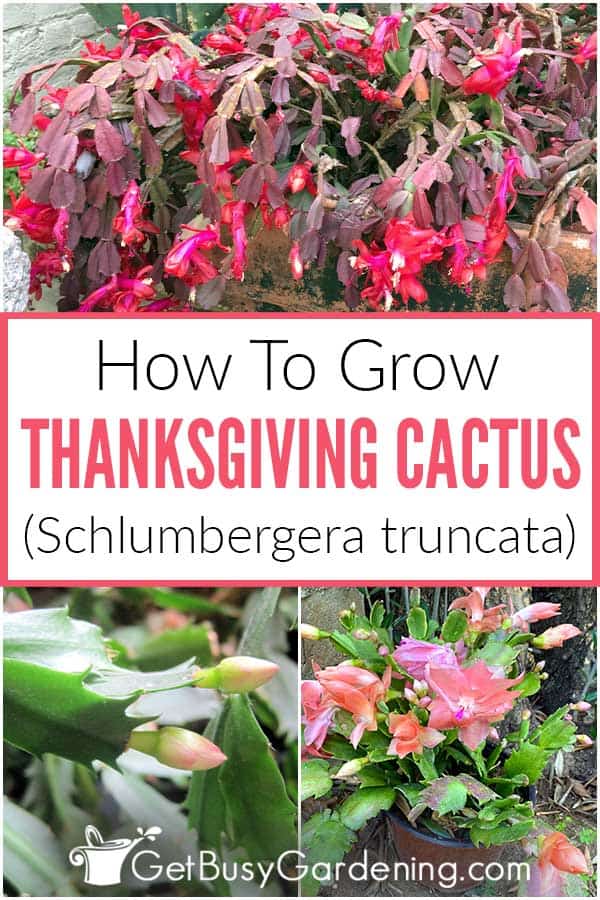
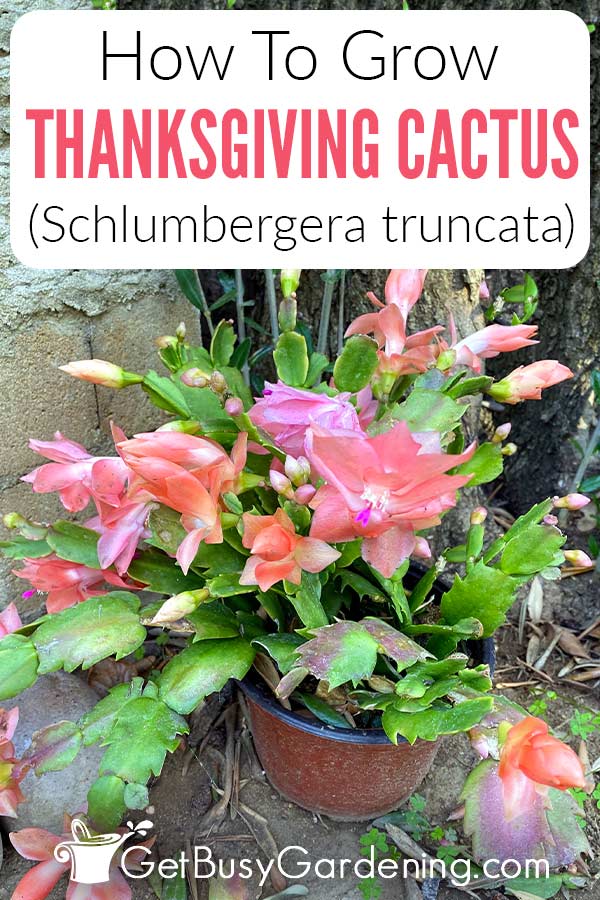



Leave a Reply